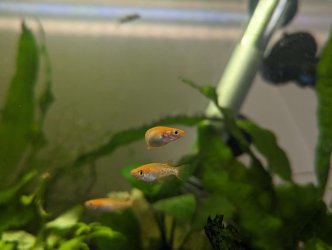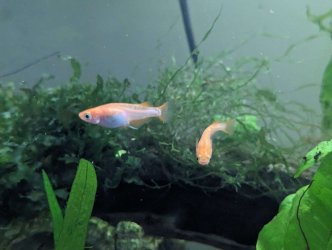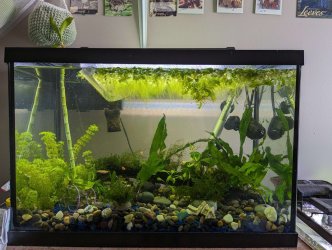TissueTenant
New Member
Tank size: 20 gallons
pH: 7.6
Ammonia/nitrite/nitrate: 0.25 / 0 / 5ppm (new fish, so the bacteria haven't caught up yet I guess, fully cycled, will do a water change to get it back down)
GH: 5 degrees
Temperature: 79 degrees F
Moderately planted
Lights on for ~6 hours per day
No medications or chemicals are used in the tank besides prime water conditioner
Tank has a lid, so the fish aren't jumping out.
I bought 8 rice fish 3 days ago, they were vibrant, active, and looked healthy at the store. They had been at the store for about 2 weeks before I got them, so they were quite settled in there. I acclimated them to my tank conditions by pouring them into a bucket, then adding a small scoop of water from my tank and putting it into their bucket every 5 minutes or so. Once the bucket was half full, I poured out most of the water and filled it up one scoop at a time until it was half full again, then put them into the tank. I left the lights off so they could adjust.
At first they were all active and swimming about, quite bright still despite the move. After about 2 hours, I noticed one was missing. I found it dead at the side of the tank, so I scooped it out. I thought it was normal, since it's not unusual for a fish or two to not make it through the acclimation, but then I woke up the next day to 2 more dead. Then more kept dying, and now I only have 3 left out of the original 8.
I also have 3 panda garras and 4 otocinclus that I got a few weeks ago that are all doing fine, so I'm not really sure why my new fish are dying. I also tried to get 8 CPDs 2 months ago, but they gradually disappeared until there were none left after 6 weeks (which is why I decided to try rice fish this time).
I did a fishless cycle before adding any fish according to the guidelines on here (took a few months), and the tank has been running for over a year now, so it's quite established by now. I'm not really sure why I can't keep any new fish alive in here : \ Any help would be greatly appreciated!
Included 2 pictures of some of the rice fish (not sure if those are the ones that died or survived, they're from the other day), and a picture of the whole tank they're in.
pH: 7.6
Ammonia/nitrite/nitrate: 0.25 / 0 / 5ppm (new fish, so the bacteria haven't caught up yet I guess, fully cycled, will do a water change to get it back down)
GH: 5 degrees
Temperature: 79 degrees F
Moderately planted
Lights on for ~6 hours per day
No medications or chemicals are used in the tank besides prime water conditioner
Tank has a lid, so the fish aren't jumping out.
I bought 8 rice fish 3 days ago, they were vibrant, active, and looked healthy at the store. They had been at the store for about 2 weeks before I got them, so they were quite settled in there. I acclimated them to my tank conditions by pouring them into a bucket, then adding a small scoop of water from my tank and putting it into their bucket every 5 minutes or so. Once the bucket was half full, I poured out most of the water and filled it up one scoop at a time until it was half full again, then put them into the tank. I left the lights off so they could adjust.
At first they were all active and swimming about, quite bright still despite the move. After about 2 hours, I noticed one was missing. I found it dead at the side of the tank, so I scooped it out. I thought it was normal, since it's not unusual for a fish or two to not make it through the acclimation, but then I woke up the next day to 2 more dead. Then more kept dying, and now I only have 3 left out of the original 8.
I also have 3 panda garras and 4 otocinclus that I got a few weeks ago that are all doing fine, so I'm not really sure why my new fish are dying. I also tried to get 8 CPDs 2 months ago, but they gradually disappeared until there were none left after 6 weeks (which is why I decided to try rice fish this time).
I did a fishless cycle before adding any fish according to the guidelines on here (took a few months), and the tank has been running for over a year now, so it's quite established by now. I'm not really sure why I can't keep any new fish alive in here : \ Any help would be greatly appreciated!
Included 2 pictures of some of the rice fish (not sure if those are the ones that died or survived, they're from the other day), and a picture of the whole tank they're in.





